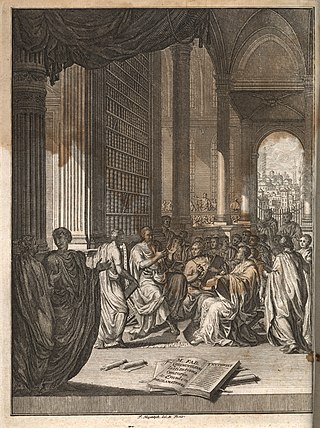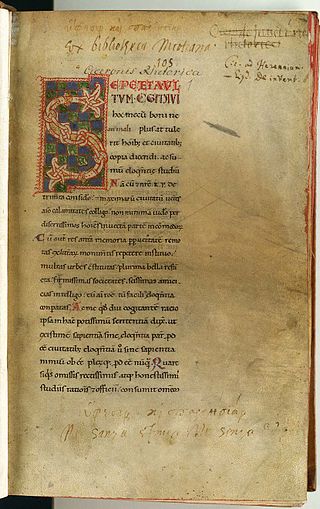
Rhetoric is the art of persuasion. It is one of the three ancient arts of discourse (trivium) along with grammar and logic/dialectic. As an academic discipline within the humanities, rhetoric aims to study the techniques that speakers or writers use to inform, persuade, and motivate their audiences. Rhetoric also provides heuristics for understanding, discovering, and developing arguments for particular situations.

Marcus Fabius Quintilianus was a Roman educator and rhetorician born in Hispania, widely referred to in medieval schools of rhetoric and in Renaissance writing. In English translation, he is usually referred to as Quintilian, although the alternate spellings of Quintillian and Quinctilian are occasionally seen, the latter in older texts.

In religious studies, homiletics is the application of the general principles of rhetoric to the specific art of public preaching. One who practices or studies homiletics may be called a homilist, or more simply, a preacher.
Pathos appeals to the emotions and ideals of the audience and elicits feelings that already reside in them. Pathos is a term used most often in rhetoric, as well as in literature, film and other narrative art.
Hermagoras of Temnos was an Ancient Greek rhetorician of the Rhodian school and teacher of rhetoric in Rome, where the Suda states he died at an advanced age.

Inventio, one of the five canons of rhetoric, is the method used for the discovery of arguments in Western rhetoric and comes from the Latin word, meaning "invention" or "discovery". Inventio is the central, indispensable canon of rhetoric, and traditionally means a systematic search for arguments.

Memoria was the term for aspects involving memory in Western classical rhetoric. The word is Latin, and can be translated as "memory".

Elocutio is a Latin term for the mastery of rhetorical devices and figures of speech in Western classical rhetoric. Elocutio or style is the third of the five canons of classical rhetoric that concern the craft and delivery of speeches and writing.

Pronuntiatio was the discipline of delivering speeches in Western classical rhetoric. It is one of the five canons of classical rhetoric that concern the crafting and delivery of speeches. In literature the equivalent of ancient pronuntiatio is the recitation of epics.

The Rhetorica ad Herennium is the oldest surviving Latin book on rhetoric, dating from the late 80s BC. It was formerly attributed to Cicero or Cornificius, but is in fact of unknown authorship, sometimes ascribed to an unnamed doctor.

Aristotle's Rhetoric is an ancient Greek treatise on the art of persuasion, dating from the 4th century BCE. The English title varies: typically it is Rhetoric, the Art of Rhetoric, On Rhetoric, or a Treatise on Rhetoric.

Owing to its origin in ancient Greece and Rome, English rhetorical theory frequently employs Greek and Latin words as terms of art. This page explains commonly used rhetorical terms in alphabetical order. The brief definitions here are intended to serve as a quick reference rather than an in-depth discussion. For more information, click the terms.

De Oratore is a dialogue written by Cicero in 55 BC. It is set in 91 BC, when Lucius Licinius Crassus dies, just before the Social War and the civil war between Marius and Sulla, during which Marcus Antonius (orator), the other great orator of this dialogue, dies. During this year, the author faces a difficult political situation: after his return from exile in Dyrrachium, his house was destroyed by the gangs of Clodius in a time when violence was common. This was intertwined with the street politics of Rome.
The art of memory is any of a number of loosely associated mnemonic principles and techniques used to organize memory impressions, improve recall, and assist in the combination and 'invention' of ideas. An alternative term is "Ars Memorativa" which is also translated as "art of memory" although its more literal meaning is "Memorative Art". It is also referred to as mnemotechnics. It is an 'art' in the Aristotelian sense, which is to say a method or set of prescriptions that adds order and discipline to the pragmatic, natural activities of human beings. It has existed as a recognized group of principles and techniques since at least as early as the middle of the first millennium BCE, and was usually associated with training in rhetoric or logic, but variants of the art were employed in other contexts, particularly the religious and the magical.

Institutio Oratoria is a twelve-volume textbook on the theory and practice of rhetoric by Roman rhetorician Quintilian. It was published around year 95 AD. The work deals also with the foundational education and development of the orator himself.

De Inventione is a handbook for orators that Cicero composed when he was still a young man. Quintilian tells us that Cicero considered the work rendered obsolete by his later writings. Originally four books in all, only two have survived into modern times. It is also credited with the first recorded use of the term "liberal arts" or artes liberales, though whether Cicero coined the term is unclear. The text also defines the concept of dignitas: dignitas est alicuius honesta et cultu et honore et verecundia digna auctoritas.

The Rhetoric to Alexander is a treatise traditionally attributed to Aristotle. It is now generally believed to be the work of Anaximenes of Lampsacus.
Cypriano Soarez y Herrera, S.J. (1524–1593) was a sixteenth-century Spanish Jesuit who wrote De Arte Rhetorica, the first Jesuit rhetoric textbook.

In classical rhetoric, figures of speech are classified as one of the four fundamental rhetorical operations or quadripartita ratio: addition (adiectio), omission (detractio), permutation (immutatio) and transposition (transmutatio).

Orator was written by Marcus Tullius Cicero in the latter part of the year 46 BC. It is his last work on rhetoric, three years before his death. Describing rhetoric, Cicero addresses previous comments on the five canons of rhetoric: Inventio, Dispositio, Elocutio, Memoria, and Pronuntiatio. In this text, Cicero attempts to describe the perfect orator, in response to Marcus Junius Brutus’ request. Orator is the continuation of a debate between Brutus and Cicero, which originated in his text Brutus, written earlier in the same year.






